Key takeaways:
- Selective mutism is an anxiety disorder that affects children’s communication in specific settings, often leading to isolation and misinterpretation by adults.
- Therapy animals, such as dogs and rabbits, provide comfort and support, helping children with selective mutism express themselves and reduce anxiety.
- The right therapy animal can create a safe space for children, facilitating communication and promoting social skills through bonding and shared experiences.
- Successful introduction of therapy animals involves creating a calm environment, gradually increasing interaction, and incorporating routines to build trust.
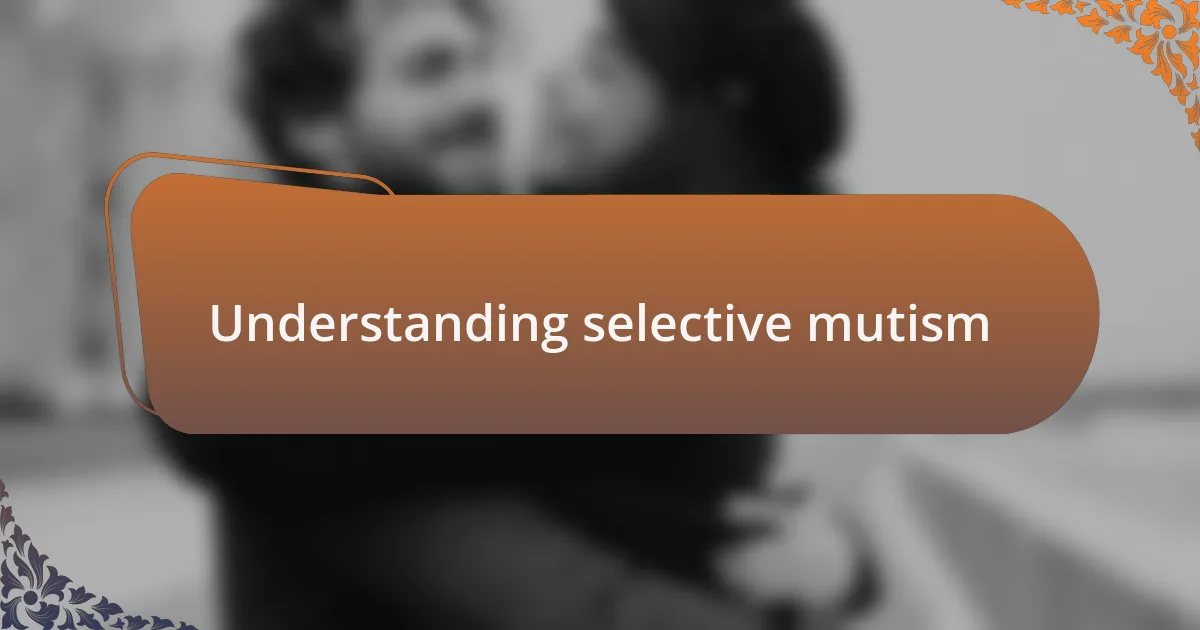
Understanding selective mutism
Selective mutism is a complex childhood anxiety disorder that can often leave parents and caregivers feeling confused and helpless. I remember meeting a child who would light up at home but suddenly froze in silence at school, a striking contrast that tugged at my heart. What makes their voice disappear in certain settings? It’s not a choice but rather an overwhelming fear that grips them, making communication feel impossible.
At its core, selective mutism is rooted in anxiety and can be a barrier to social interactions. I’ve seen firsthand how isolating this condition can be, as a young girl I knew often avoided eye contact and retreated into herself during group activities. Isn’t it heartbreaking to realize that children who want to connect feel trapped in their own silence?
The journey to understanding selective mutism is not a straight path. Adults often misinterpret those who struggle to speak in specific settings as being rude or aloof, when in reality, they may be battling their inner turmoil. Have we stopped to consider that each quiet moment might be a testament to the incredible effort it takes for these children to simply exist in their environment?
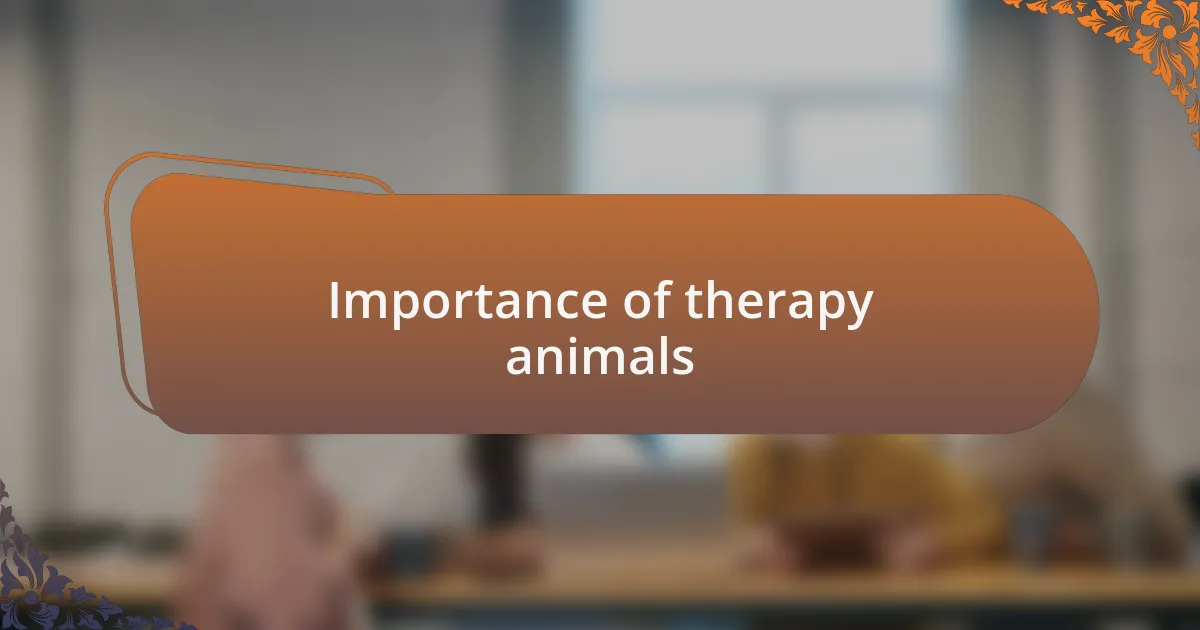
Importance of therapy animals
Therapy animals play a crucial role in easing the anxiety associated with selective mutism. I remember watching a young boy hesitant to speak during therapy sessions, but when his therapy dog curled up beside him, I saw an instant transformation. The warmth of that canine presence gave him the security to express himself, bridging the gap between his thoughts and words.
The bond formed between a child and a therapy animal goes beyond mere companionship; it fosters trust and comfort in a world that may feel intimidating. I often think about how that quiet nudge from a furry friend can bring a smile when words are hard to find. Can you imagine the relief a child must feel, knowing they have a supportive partner who doesn’t judge or pressure them to speak?
Moreover, therapy animals can create a calming environment that reduces the rigid expectations children might face in social situations. I witnessed a group session where children, typically silent, began to open up while engaging with a gentle rabbit. Isn’t it remarkable how the presence of these animals can shift the dynamics of communication, enabling children to find their voice at their own pace?
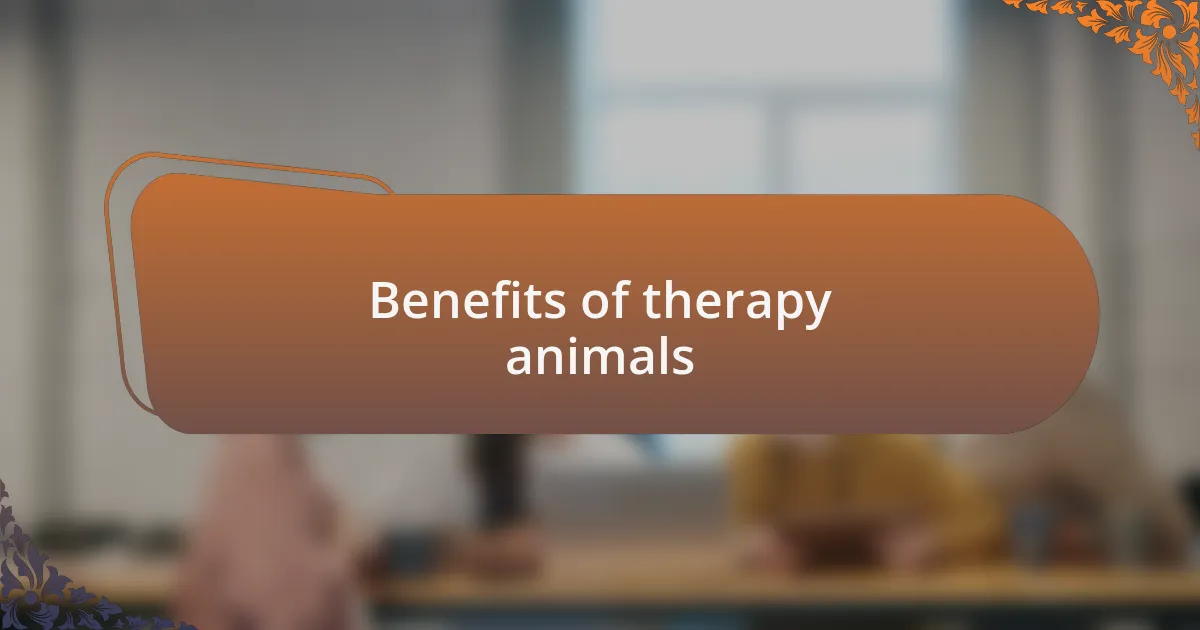
Benefits of therapy animals
One of the standout benefits of therapy animals is their ability to provide unconditional support, which can be incredibly empowering for children experiencing selective mutism. I remember a session where a young girl, usually filled with anxiety, found herself gently stroking a therapy cat. The cat’s purring seemed to dissolve her stress, creating a serene moment in which she felt free to vocalize her thoughts, even if just a whisper. Isn’t it fascinating how that simple exchange changed her outlook?
Additionally, therapy animals often serve as a bridge between the child and the therapist, facilitating communication in a way that feels less intimidating. I recall a poignant instance when a timid boy was encouraged to share his feelings by talking to his therapy dog instead of directly to his therapist. It struck me how the boy’s words flowed effortlessly to the dog, as if he were confiding in a trusted ally rather than facing an adult who might feel overwhelming. This connection can make the therapeutic process not only more effective but also far more relatable for the child.
Finally, therapy animals contribute to building social skills gradually. I’ve seen children who would normally shy away from group interactions become more engaged simply by playing with a friendly dog during therapy. It was heartwarming to witness the ice break as kids laughed and interacted with each other through the shared joy of being with the animal. How often do we overlook the power of play in fostering connections? Through these experiences, children can learn to navigate social scenarios more comfortably over time.
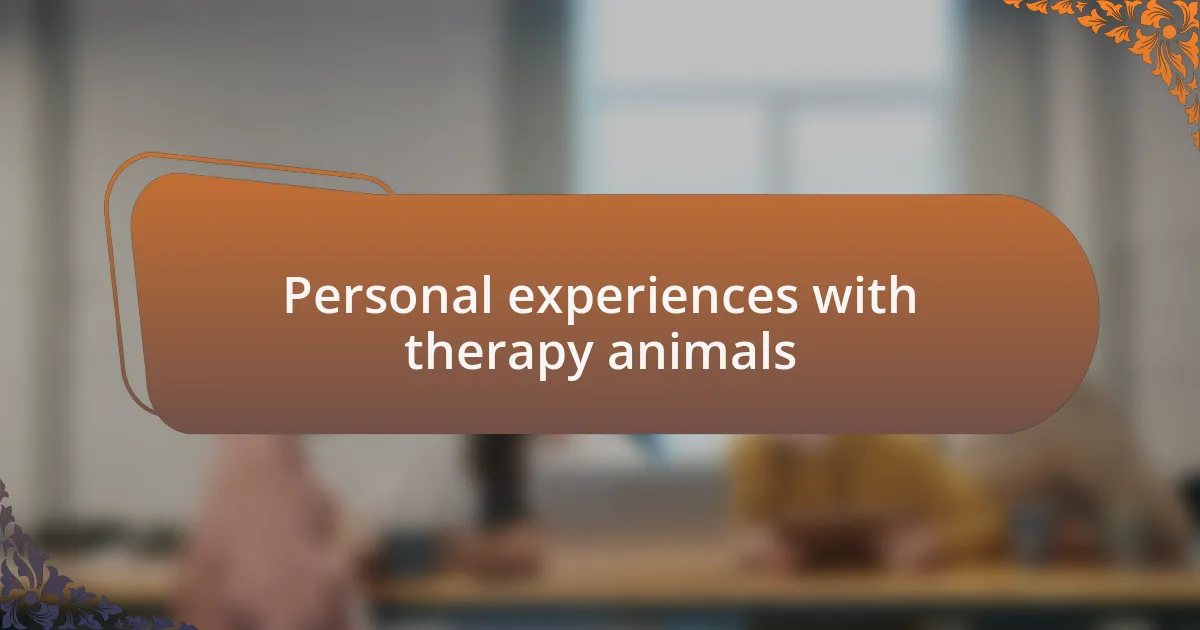
Personal experiences with therapy animals
I vividly remember my first encounter with a therapy rabbit that had been brought into our training session. Watching a quiet young girl curl up with the soft creature was eye-opening; she visibly relaxed, and I could see a lightness in her demeanor. As she gently stroked the rabbit, I wondered if the warmth of that furry companion was unlocking her voice in ways we had yet to explore.
One of the most moving experiences occurred when a therapy horse visited our center. It was instructive to see how instinctively children gravitated toward such a majestic animal. There was a boy who had rarely spoken more than a few words in a session, but as he brushed the horse’s coat, he began to share stories about his own pet at home. The innocence and connection formed in that moment prompted me to think: can animals truly stimulate our emotional openings?
I have also observed how therapy animals facilitate those critical first steps toward independence. During a group session with a therapy dog, I watched as a previously introverted child not only engaged with the dog but also took the leap to lead a small group discussion. It was exhilarating to witness; I couldn’t help but reflect on how sometimes, all we need is a gentle nudge—and perhaps a wagging tail—to find our voice and share our stories.
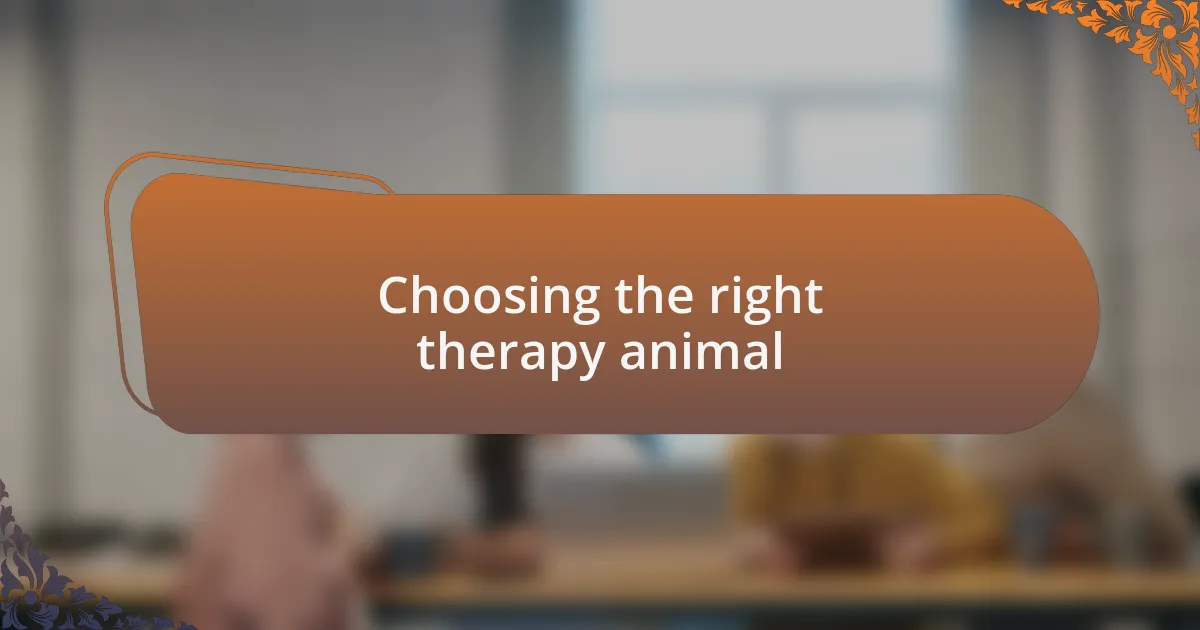
Choosing the right therapy animal
Choosing the right therapy animal can feel daunting, especially given the unique needs of each individual. I recall a moment when a family was deciding between a dog and a rabbit for their child struggling with selective mutism. As we discussed the child’s preferences and temperament, I realized how critical it was to find an animal that not only matched her personality but also resonated with her soothing energy. How do we ensure that the animal we choose will truly connect?
Another insightful experience stands out when a client was introduced to a therapy cat. This soft, purring presence provided an unexpected sense of security that transformed her anxiety into calmness. Watching her slowly open up during their sessions led me to reflect on the gentle power of cats in creating a safe space. It’s amazing to see how the right animal—whether it’s furry, scaly, or feathery—can evoke a sense of ease and trust in someone who struggles to communicate.
When contemplating the choice of a therapy animal, factors such as the animal’s demeanor and the individual’s comfort level with different animals must be prioritized. I once witnessed a child flourish when paired with a small therapy pig—its quirky character brought out smiles and giggles that I hadn’t seen before. It really made me think: could the uniqueness of the animal be the very catalyst to breaking through communication barriers? Reflecting on these experiences, it becomes clear that the bond between a therapy animal and an individual can be instrumental in fostering courage and connection.
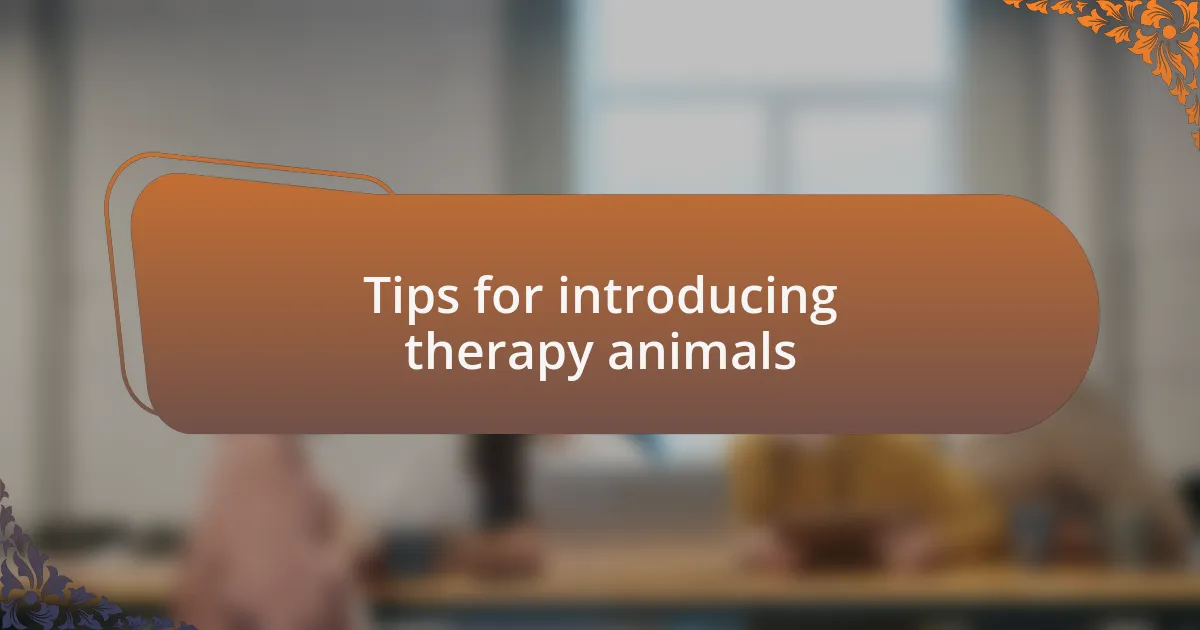
Tips for introducing therapy animals
When introducing a therapy animal to someone, it’s essential to create a peaceful environment. I remember a time when I facilitated an introduction between a shy child and a friendly golden retriever. We made sure the dog was calm and on a leash while the child sat at a safe distance, observing the dog’s gentle demeanor. This approach allowed the child to feel in control, fostering a welcoming atmosphere that made the first encounter less intimidating. Have you ever noticed how a quiet space can help ease anxiety?
Gradually increasing the interaction can also be beneficial. During another session, I observed a young girl become more comfortable as she was gently encouraged to pet a therapy rabbit—first from behind a barrier, then closer as her confidence grew. I saw her initial hesitation transform into curiosity, as she discovered the warmth of the rabbit’s fur. Isn’t it remarkable how taking small steps can lead to substantial progress?
Lastly, don’t underestimate the power of routine in these introductions. When I worked with a family who incorporated their therapy dog into daily activities, the bond deepened quickly. The child began to speak more around the dog while helping with feeding and walking, turning these tasks into a delightful experience. It’s clear that building familiarity and trust can open doors that once seemed tightly shut. How have you seen routines transform interactions in your experiences?